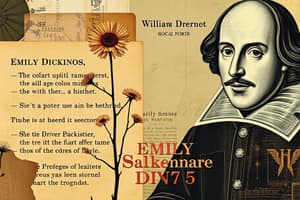Podcast
Questions and Answers
What theme is primarily explored in 'I'm Wife - I've Finished That'?
What theme is primarily explored in 'I'm Wife - I've Finished That'?
- The importance of education for women
- Roles and identity related to marriage for women (correct)
- The pleasures of domestic life
- The significance of career choices for men
What does the tone of the poem suggest?
What does the tone of the poem suggest?
- A straightforward dismissal of societal roles
- A clear acceptance of marriage as fulfilling
- A joyful celebration of domesticity
- Ambivalence between assertiveness and resignation (correct)
How does Dickinson's use of imagery in the poem function?
How does Dickinson's use of imagery in the poem function?
- It evokes traditional roles associated with being a wife (correct)
- It emphasizes the struggles of men in society
- It promotes the notion of gender equality
- It idealizes the freedom of single life
What literary device is notably used in 'I'm Wife - I've Finished That'?
What literary device is notably used in 'I'm Wife - I've Finished That'?
What critical interpretation do scholars often associate with the poem?
What critical interpretation do scholars often associate with the poem?
Flashcards are hidden until you start studying
Study Notes
Overview of "I'm Wife - I've Finished That" by Emily Dickinson
-
Theme of Identity
- Explores roles and identity, particularly related to marriage and social expectations for women.
- Reflects on the concept of being defined by one’s relationship to others.
-
Tone and Mood
- Ambivalent tone; oscillates between assertiveness and resignation.
- May convey a sense of irony regarding the idea of fulfillment through marriage.
-
Structure and Form
- Written in Dickinson’s characteristic style: short lines, slant rhyme, and unconventional punctuation.
- Use of dashes creates pauses, emphasizing certain thoughts and feelings.
-
Imagery and Symbolism
- Domestic imagery may evoke traditional roles associated with being a wife.
- Symbolism of ‘finishing’ suggests a completion of expectations but also raises questions about personal agency.
-
Key Messages
- Challenges the romantic notion of marriage as a complete and fulfilling role for women.
- Suggests that traditional roles may limit personal fulfillment and identity.
-
Literary Devices
- Use of paradox: Being a wife is seen as a conclusion, yet implies a lack of continued growth.
- Contrast between societal expectations and personal reality, highlighting the tension within the role.
-
Critical Interpretation
- Scholars often discuss the poem in the context of the feminist movement and the confinement of women’s identities.
- The poem is seen as a precursor to modern feminist literature, questioning the nature of womanhood in a patriarchal society.
Theme of Identity
- Explores the complexities of identity, specifically within the context of marriage and societal expectations for women.
- Examines the concept of being defined by one’s relationship to others, questioning if marriage truly defines a woman’s identity.
Tone and Mood
- Exhibits an ambivalent tone, fluctuating between assertive declaration and resigned acceptance.
- Hints at irony surrounding the idea of fulfillment through marriage, suggesting that it may not be the conclusive state it is often perceived to be.
Structure and Form
- Follows Dickinson’s typical poetic style, characterized by short lines, slant rhyme, and non-standard punctuation.
- Uses dashes strategically to create pauses, emphasizing specific thoughts and feelings, adding layers of meaning to the poem.
Imagery and Symbolism
- Domestic imagery evokes traditional roles associated with being a wife, suggesting a confinement within societal expectations.
- The symbolism of "finishing" implies a conclusion, suggesting that fulfilling societal expectations may not necessarily lead to personal fulfillment.
Key Messages
- Challenges the idealized perception of marriage as a complete and fulfilling role for women, questioning its ability to define a woman’s identity.
- Implies that traditional roles may limit personal fulfillment and the development of a unique identity.
Literary Devices
- Utilizes paradox to highlight the tension between societal expectations and personal reality: being a wife is presented as a conclusion, but it also implies a lack of further personal growth.
- Creates a contrast between societal expectations and the individual experience of a woman within marriage, emphasizing the strain that conventional roles can create.
Critical Interpretation
- Scholars often interpret the poem within the broader context of the feminist movement and the societal constraints surrounding women's identities.
- The poem is often viewed as a precursor to modern feminist literature, challenging the traditional definitions of womanhood within a patriarchal society.
Studying That Suits You
Use AI to generate personalized quizzes and flashcards to suit your learning preferences.




